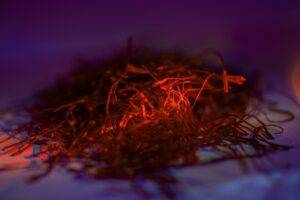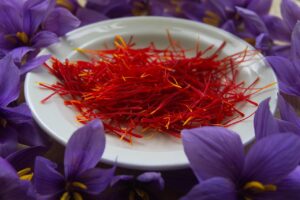Celebrating Nature’s Most Precious Gift
Saffron has captivated humanity for millennia. This vibrant crimson spice, often called “red gold,” carries a legacy of luxury, healing, and culinary excellence. At Zarafron, we celebrate the extraordinary nature of this ancient treasure that continues to enchant the modern world. Join us as we explore the remarkable story behind one of nature’s most precious gifts.
1. The Labor of Love: A Harvest Like No Other
Every thread of saffron represents an extraordinary commitment to craftsmanship. Each delicate Crocus sativus flower produces just three red stigmas, which must be hand-harvested during a brief autumn bloom. The process begins at dawn when the flowers are still closed, preserving the stigmas at their peak potency.
Skilled harvesters, often using tweezers or their fingertips, meticulously pluck each thread. This careful dance between human and nature requires patience, precision, and generations of expertise. Remarkably, it takes approximately 150,000 to 170,000 flowers to produce a single kilogram of dried saffron, making it the most labor-intensive crop in the world.
2. The World’s Most Precious Spice
When people call saffron expensive, they’re not exaggerating. Premium saffron can cost over $5,000 per pound or $300 per ounce, making it worth more than gold by weight. This extraordinary value isn’t arbitrary; it directly reflects the intensive labor, short harvest window, and limited yield per flower.
Consider this: a single pound of saffron represents the careful harvesting of up to 75,000 flowers, each containing just three delicate threads. The entire annual global production of saffron is estimated at less than 300 tons, a tiny fraction compared to other spices. This scarcity, combined with growing global demand, continues to secure saffron’s position as the world’s most valuable spice.
3. Ancient Heritage: 3,000+ Years of Cultural Significance
Saffron’s recorded history stretches back over three millennia. This remarkable spice appears in Persian, Egyptian, Greek, Roman, and Chinese historical texts, where it was treasured for its color, flavor, and medicinal properties.
Ancient civilizations valued saffron beyond culinary applications. In Egypt, Cleopatra bathed in saffron-infused water to enhance her beauty. Persian kings slept on saffron-filled mattresses. Greek mythology tells of mortals transformed into crocus flowers. Medieval European courts used saffron as currency, medicine, and perfume. Throughout history, this golden spice has symbolized wealth, healing, and spiritual significance across diverse cultures.
4. The Science Behind Saffron’s Magic
Saffron’s distinctive properties come from several bioactive compounds:
Crocin: Responsible for saffron’s vibrant golden-yellow color, this carotenoid also offers powerful antioxidant benefits.
Safranal: Creates saffron’s characteristic aroma and contributes to its mood-enhancing effects.
Picrocrocin: Delivers saffron’s distinctive bitter-sweet flavor profile.
Modern research has confirmed what traditional healers knew for centuries. These compounds offer remarkable health benefits. Studies suggest saffron may help alleviate depression symptoms, improve memory function, reduce inflammation, and potentially protect against certain neurodegenerative conditions. Its antioxidant properties are among the highest found in the spice world.
5. Global Saffron Cultivation: A Worldwide Tradition
While saffron grows in several regions, including Spain, Kashmir, Greece, Morocco, and Italy, saffron cultivation represents a global heritage. Different regions bring their own traditions and expertise to this delicate crop. Each growing region, with its unique climate and cultivation practices, contributes to the diversity and richness of saffron available worldwide.
Saffron cultivation represents a living cultural heritage. Families across different regions have passed down harvesting techniques for generations, preserving traditions that predate modern agriculture. This deep connection between people, land, and crop creates a quality and authenticity that’s impossible to replicate through industrial farming methods.
6. The Art of Authentication: Recognizing True Quality
As with any precious commodity, the saffron market faces challenges with adulteration and counterfeiting. True saffron connoisseurs understand how to identify authentic, high-quality threads:
Color: Premium saffron threads should have deep red stigmas with orange-yellow tips.
Aroma: Authentic saffron releases a distinctive honey-like, earthy fragrance.
Taste: The flavor profile combines floral, honey-like sweetness with subtle bitterness.
Moisture: Quality saffron should be completely dry but not brittle.
The ISO (International Organization for Standardization) classifies saffron into four categories based on crocin content. The highest grade, Category I, must contain at least 190 units of crocin, while the lowest acceptable grade (Category IV) contains a minimum of 80 units. At Zarafron, we ensure every thread meets the highest quality standards through rigorous testing and direct relationships with traditional growers.
7. Saffron’s Spiritual and Religious Significance
Throughout history, saffron has held profound spiritual importance across Abrahamic traditions and other faith systems. Buddhist monks adopted saffron-dyed robes as symbols of renunciation and humility. Hindu traditions incorporate saffron in sacred rituals and as a symbol of purity.
In Christianity, saffron appears in traditional foods like Easter saffron bread and Cornish saffron buns, connecting faith celebrations with this divine ingredient. This cross-cultural spiritual significance underscores saffron’s universal appeal as more than just a culinary element. It serves as a bridge between the earthly and divine realms.
8. Saffron’s Wellness Renaissance
While modern science is just beginning to validate saffron’s health properties, traditional medicine systems have valued this spice for millennia. Ayurvedic practitioners have long prescribed saffron for digestion, inflammation, and female reproductive health. Traditional medicine practices used saffron for mood enhancement and cardiovascular support.
Today’s clinical research reveals promising evidence for saffron’s effectiveness in:
- Supporting emotional well-being and mood regulation
- Enhancing cognitive function and memory
- Providing antioxidant protection against cellular damage
- Promoting eye health and protecting against macular degeneration
- Supporting healthy hormonal balance
This convergence of ancient wisdom and modern science represents an exciting frontier in natural wellness approaches.
9. The Culinary Magic: How Saffron Transforms Food
Saffron’s culinary applications span virtually every global cuisine. From Spanish paella to Indian biryani, Persian tahdig to Italian risotto Milanese, saffron elevates dishes with its distinctive color, aroma, and flavor.
What makes saffron particularly fascinating in cooking is its unique preparation method. To maximize flavor extraction, chefs typically steep saffron threads in warm (not boiling) liquid for 10 to 20 minutes before adding them to a dish. This process, known as “blooming,” releases the full spectrum of flavor compounds and vibrant color. Just a few threads can transform an entire pot of basmati rice or enrich a pot of comfort food.
10. Sustainability Challenges and Future Prospects
As global demand for authentic saffron grows, traditional growing regions face sustainability challenges. Climate change threatens the delicate balance needed for optimal crocus cultivation. Meanwhile, the labor-intensive harvesting process presents economic challenges as younger generations migrate to urban areas.
The future of saffron depends on conscious consumers who value authentic production methods and fair compensation for growers. Innovative approaches like protected designation of origin certifications, direct trade relationships, and education about proper saffron appreciation help preserve this ancient tradition for future generations.
Organizations committed to authentic spices like Zarafron play a vital role in sustaining the saffron tradition by connecting conscientious consumers with ethical producers.
The Zarafron Difference: Honoring Saffron’s Legacy
At Zarafron, we believe that experiencing true saffron is experiencing a piece of living history. Every thread in our collection carries a story of heritage, care, and craftsmanship spanning thousands of years. We partner exclusively with carefully vetted U.S.-based who practice time-honored cultivation methods, ensuring both exceptional quality and ethical sourcing.
Our commitment extends beyond providing premium saffron. We invite you to join our community of saffron enthusiasts exploring the rich cultural heritage, wellness benefits, and culinary possibilities of this extraordinary spice. Through education, appreciation, and conscious consumption, together we can ensure this ancient treasure continues to thrive.
Ready to experience the transformative power of authentic saffron? Join our early access waitlist today and be the first to know about our upcoming product launches, exclusive educational content, and special offers. Connect with the timeless tradition of “red gold” and discover why saffron has captivated humanity for over three millennia.
Sign up for our waitlist and begin your journey into the fascinating world of saffron.




